How to write pounds, shillings and pence pre-decimal money
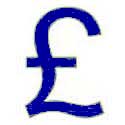
This page is about writing various amounts of the pre-decimal UK pounds, shillings and pence symbols correctly, and it comments on their Roman origin. How the currency was divided up and equivalents of pre-decimal money are on another page. You may like to read it before going on with this one. Yet another page is about how the money was spoken.
____
By the webmaster, based on living and working with pre-decimal currency over many years
Because the old money is probably unfamiliar to you, the symbols in the following text are written in italics to distinguish them from the other text on the page. In practice, the symbols were not normally written in italics.
Symbol for the pre-decimal penny and how to write several pennies
The symbol for an old penny was d. So one penny was written as 1d.
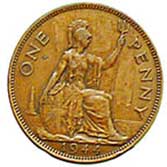
One penny, written as 1d.
More than one penny was written as the number of pence with d after it, e.g. 4d. The maximum was of course was 11d, as 12d became a shilling.
Symbols for pre-decimal halfpennies and farthings and how to write them
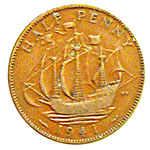
A halfpenny was written as ½d.
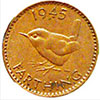
A farthing, i.e. a quarter of a penny, was written as ¼d.
Symbol for the shilling and how to write several shillings
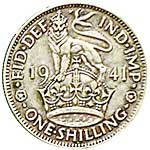
The symbol for a shilling was s but whole numbers of shillings were normally written with a slash and a hyphen after the number.
So, for example, one shilling was written as 1/- and twelve shillings were written as 12/- and occasionally as 12s.
Amounts of shillings and pennies - for example five shillings and three pennies - was written as 5/3.
More complex amounts - for example six shillings, eleven pence and three farthings - was written as 6/11¾.
How to write pounds, shillings and pence
The symbol for the pound did not change when British currency went decimal. In the old pre-decimal money, the pounds, shillings and pence were separated by a slash, dot or dash with a pound sign £ in front.

One example of how to write pre-decimal pounds shillings and pence
So, for example ten pounds, seventeen shillings and six pence was written as £10/17/6 or £10.17.6 or £10-17-6.
For bills receipts and other formal documents, there were ready-printed columns for each of the pounds, shillings and pence, e.g. | 10 | 17 | 6 |.
Rounded pounds either had zeros like | 10 | 0 | 0 | or as dashes like | 10 | - | - |.
Elsewhere on the website there are various examples of how money was written this way, see for example the receipt for a holiday and the second menu beginning 'furniture costs 1930s/40s' - available via the hampburger - where the images of bills and receipts are thumbnails which enlarge to be legible when clicked. Also see my father's accounts.
The origin of the pounds, shillings and pence symbols
The pre-decimal British currency was widely called the pounds shillings and pence system. It was written as the £sd system. You may wonder hat has l to do with pounds and d to do with pence. The answer lies in their Roman origin. l, s and d are the initials of the Roman coins 'librae', 'solidi', and 'denarii' which influenced the British monetary system. Over time, the l became the stylised £ that we know today.
| sources | webmaster | contact |
Text and images are copyright
If you can add anything to this page or provide a photo, please contact me.



